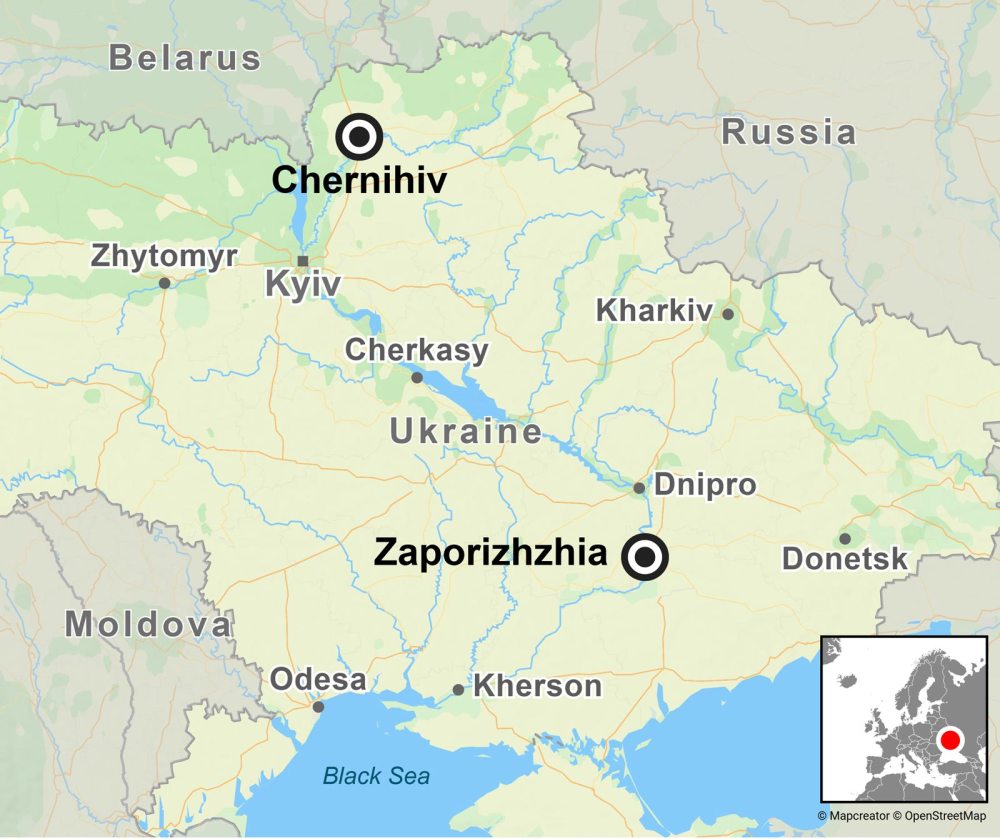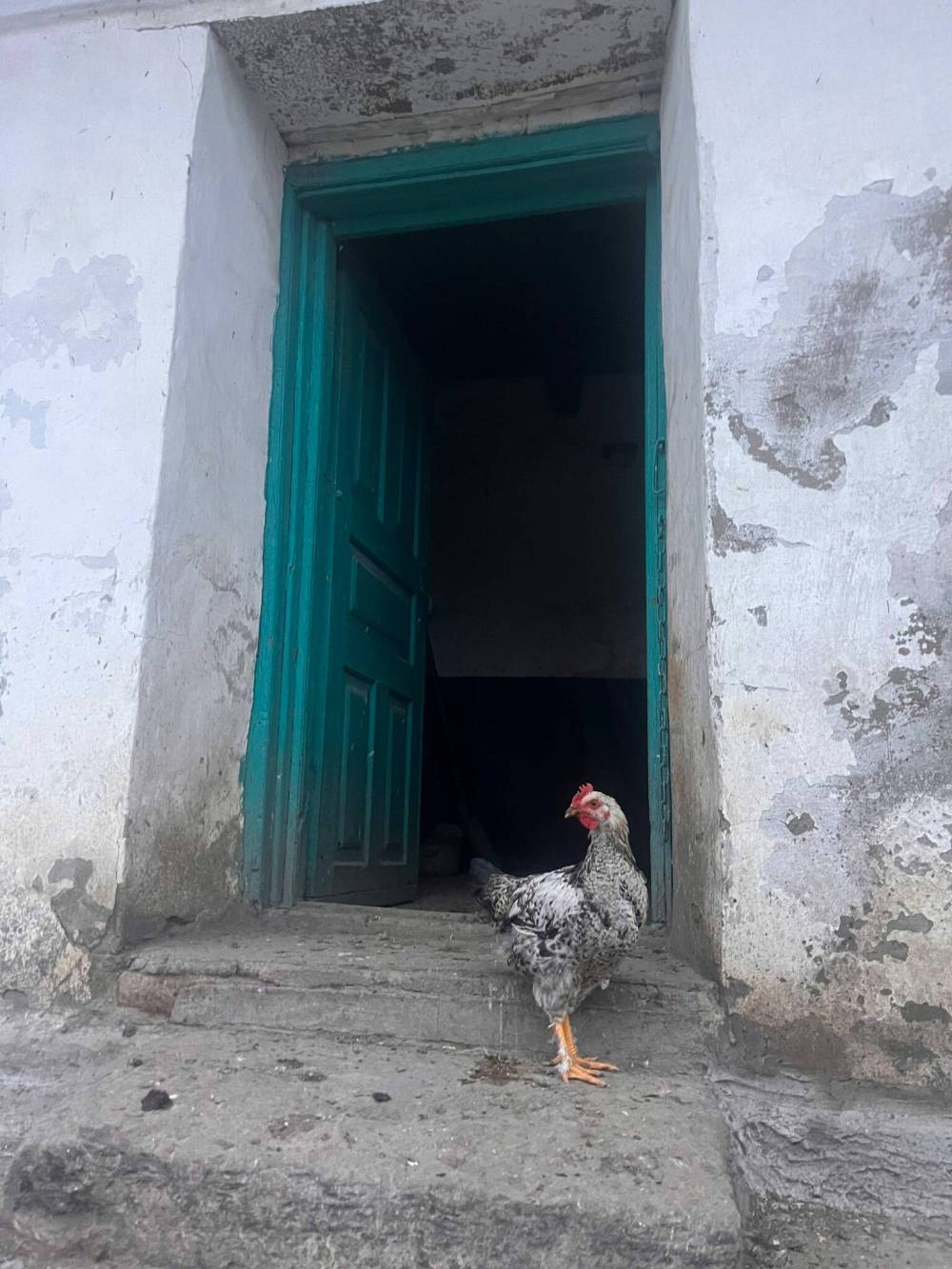The land remembers Nearly all Hutterites in Manitoba can trace their ancestry to a small area in Ukraine. Writer Melissa Martin visits the Zaporizhzhia region to see if any signs of their history can still be found
Read this article for free:
or
Already have an account? Log in here »
To continue reading, please subscribe:
Monthly Digital Subscription
$0 for the first 4 weeks*
- Enjoy unlimited reading on winnipegfreepress.com
- Read the E-Edition, our digital replica newspaper
- Access News Break, our award-winning app
- Play interactive puzzles
*No charge for 4 weeks then price increases to the regular rate of $19.00 plus GST every four weeks. Offer available to new and qualified returning subscribers only. Cancel any time.
Monthly Digital Subscription
$4.75/week*
- Enjoy unlimited reading on winnipegfreepress.com
- Read the E-Edition, our digital replica newspaper
- Access News Break, our award-winning app
- Play interactive puzzles
*Billed as $19 plus GST every four weeks. Cancel any time.
To continue reading, please subscribe:
Add Free Press access to your Brandon Sun subscription for only an additional
$1 for the first 4 weeks*
*Your next subscription payment will increase by $1.00 and you will be charged $16.99 plus GST for four weeks. After four weeks, your payment will increase to $23.99 plus GST every four weeks.
Read unlimited articles for free today:
or
Already have an account? Log in here »
Hey there, time traveller!
This article was published 21/03/2025 (246 days ago), so information in it may no longer be current.
ZAPORIZHZHIA, Ukraine — Outside Zaporizhzhia, a rugged two-lane road curls east and south. It passes through one military checkpoint, then another; after each, the road grows emptier of civilian vehicles and even the air seems heavier, thick with the tension of war.
At a crossroads, we pull the car to a stop. Outside a small shop, vacant-eyed soldiers squat on the pavement, sipping takeout coffee from paper cups. Inside, a young boy — the owners’ son — darts around the floor, slyly gesturing to a shelf of energy drinks that are wildly popular with frontline fighters.
He sure knows his target audience, I think.
If we were to continue south from this crossroads, in just 30 kilometres we would reach the destroyed city of Orikhiv, where the Ukrainian army holds back Russian forces pushing toward Zaporizhzhia, a regional capital of about 700,000 people.
Instead, we turn east, passing the ruins of a bomb-blasted factory and several smashed houses, before the land spreads out a picturesque blanket of rural green. It looks, to be honest, a lot like Manitoba, flat fields of late-season wheat bordered by rows of windbreak trees.
We pass through a cluster of communities, including the village of Kushchove, a row of quaint khata huts, or peasant homes, gaily painted in bright blues and yellows.
THE ASSOCIATED PRESS FILES A field of wheat in the Zaporizhzhia region. 
In peaceful times, these are quiet villages.
“People lived, people worked,” regional head Alla Andrusyeva says, speaking in Ukrainian through a translator. “They were just farmers who took care of the land.”
It’s a cool day in late autumn. We met Andrusyeva at her office in the village of Novoivanivka, a spartan room with powder-blue wallpaper, a few chairs, a desk piled with paperwork and a tiny Ukrainian flag.
Outside the window, flatbed trucks hauling stacks of firewood rumble down the pockmarked road, part of a foreign charity effort to supply residents through the winter.
Despite their proximity to the front, humanitarian conditions in these villages have been manageable. Financial and food aid has been “very good,” Andrusyeva says, with frequent deliveries of safe drinking water.
There are unpredictable electricity blackouts and internet connectivity is bad, but that was true even before the war.
“We were waiting to put in a network tower,” she says, with a sigh. “We submitted all the documents right before the full-scale invasion.”
Here, the biggest challenge is the ever-present danger. The front line is about 25 kilometres away; nearly every day, long-range Shahed assault drones, missiles and powerful laser-guided KAB bombs shriek overhead.
Many of the area’s 460 residents have fled, especially those with children; the school is closed, along with the kindergarten.
Since a Ukrainian counteroffensive pushing south from Orikhiv fizzled out in late 2023, the front line there has been mostly stable.
But that could change at any moment, and if Russian forces advance much further, these villages will be in range of artillery and the small explosive drones that hunt soldiers and civilians across the line of contact.
ANDRIY ANDRIYENKO / UKRAINE'S 65TH MECHANISED BRIGADE / THE ASSOCIATED PRESS FILES A Ukrainian fortification line is seen on the frontline in Zaporizhzhia region in December.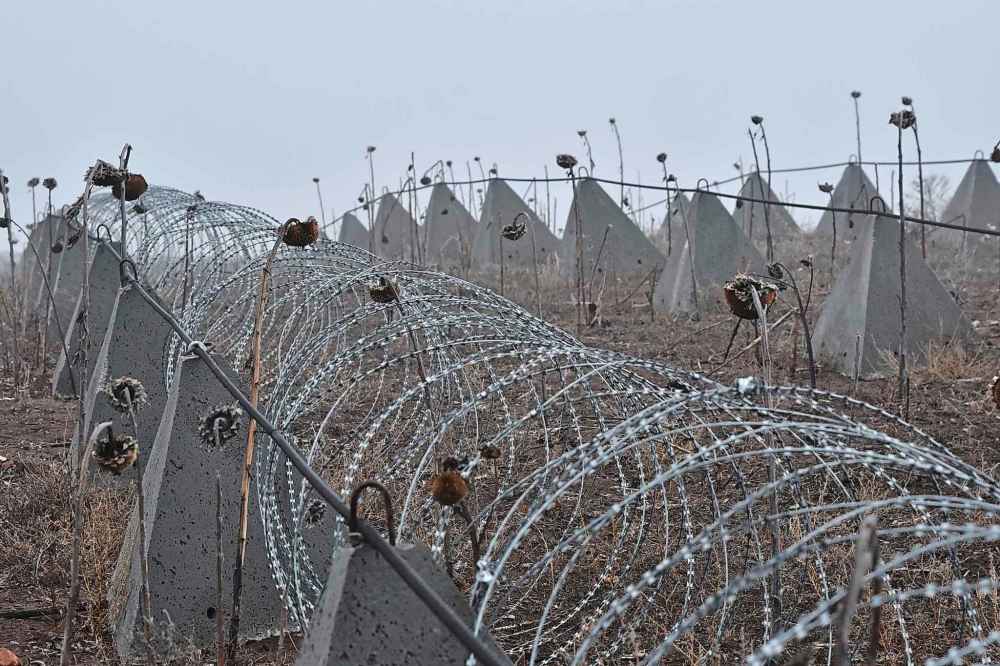
“This is the biggest fear,” Andrusyeva says. “People are just watching what’s happening with the front line right now. That is the most difficult part. We live in an anxious state, just like everyone else.”
What gets them through?
“Hope,” she says. “And faith.”
As Andrusyeva speaks, her voice is weary. She’s been the elected head of these villages for 21 years; since the full-scale invasion in February 2022, she and other local officials have not had a single day off. People needing help turn up at their office or homes at all hours.
Yet to keep her community surviving provides its own motivation. These villages, Andrusyeva says, are “very pro-Ukrainian, and very patriotic.” In 2023, when exhausted fighters came from the east to take up new positions south of Zaporizhzhia, some elderly residents invited them to stay in their houses.
Those invitations came at great risk, given how soldiers’ locations are targeted, and Andrusyeva stresses there is no military presence in the village now. Yet it’s hard to look at the fighters passing through, she says, without wanting to do something to comfort them.
“They’re not robots, they’re soldiers,” she says. “They don’t want to sit in those trenches. They never know how long they need to stay there, to suffer longer. They also need a place to stay, a place to rest, and you look at them and almost want to cry.”
There is something else I want to ask her. It’s the reason why we came to these small farming villages on the doorstep of war. It’s about the history these places — in particular, Kushchove — hold in their soil, a history that forever binds them with Manitoba.
Once, over a century ago, these lands were farmed by Hutterite and Mennonite settlers, who went on to eke out a new life on the Canadian Prairies. Some of my friends, I tell Andrusyeva, have ancestors who farmed these same fields. With these villages under threat of destruction, so are any remaining vestiges of that history.
Andrusyeva nods. Of course, she says, villagers know about what they call the area’s “German” history, but mostly in sparse stories.
MELISSA MARTIN / FREE PRESS Alla Andrusyeva, the elected head of a cluster of villages, says residents live “in an anxious state.”
Local memory in this part of Ukraine does not stretch back too far: most residents were moved here during the Soviet era, often from Western Ukraine. The oldest resident came in the late 1960s; Andrusyeva herself arrived in ’84.
Today, she continues, there are not many “German buildings” left. There used to be more — in the 1970s, Novoivanivka still had a small “German house” and school — but during years of scarcity they were slowly dismantled for valuable building materials, especially high-quality brick. Other structures were lost to fire or simply reclaimed by nature.
So, is there any trace left of the Hutterites and Mennonites who once called this land home?
Andrusyeva is prepared for this question. She’d heard why we were coming, and the day before our visit, she’d canvassed longtime villagers, brainstorming what — if anything — remains. They came up with two places, two “German houses” that are still standing.
One is off-limits, as it’s in a zone used by the military, and it would be dangerous to get too close.
But the other one we can visit; it’s just a few kilometres down the road. The woman who lives there, Andrusyeva thinks, will be quite happy to see us.
One day in 1859, a blacksmith, Michael Waldner, was taking a train across south-central Ukraine. As he neared his destination he asked the conductor to slow down, then jumped off the carriage, tumbled, hit his head, and fell unconscious.
While Waldner slept, he dreamed of angels, and those angels had a message. When he returned to his Hutterite settlement, a humble farming colony called Hutterdorf southeast of Zaporizhzhia, he prayed, and told others about the vision he’d received.
It was time, Waldner believed, for Hutterites to revive Gütergemeinschaft, or community-of-goods, the distinctive communal lifestyle at the heart of their culture and faith.
Under this system, Hutterites live and work together, following patterns they’d developed and polished over hundreds of years. They draw no individual wages, but share equally in all of a community’s assets, and the community provides for their needs from cradle to grave.
This practice, Hutterites believe, is in keeping with Biblical teachings about Jesus’s early followers, particularly a passage that reads, “all that believed were together, and had all things in common.” It’s a way of life they’d cherished and lost — until Waldner’s vision.
“Throughout Hutterite history, dreams are actually quite significant, and that’s probably because dreams are so important in the Bible as well,” says Kenny Wollmann, a historian and member of Baker Community near MacGregor, Man.
For Hutterites, Waldner’s dream came at a pivotal moment. Their time in Ukraine marked “a low point” in the sect’s history, Wollmann says. Centuries of struggle had left them impoverished, their numbers badly diminished. They’d been forced to abandon communal living and subsist at the mercy of the imperial Russian nobility that then ruled Ukraine.
Founded in Austria in the early 16th century as part of the Anabaptist movement, the Hutterites’ early years were difficult; one of their first leaders, Jakob Hutter, was arrested by Catholic authorities and burned at the stake as a heretic.
Yet after surviving those initial tribulations, the Hutterites flourished. By the early 17th century, their ranks had swelled to between 20,000 and 30,000 believers living in over 100 communities, largely in the Moravia region of what is now the Czech Republic.
They were prosperous then, renowned as craftsmen and doctors. They established the first kindergartens — more than 200 years before mainstream Germans — and wrote books documenting their history and beliefs. Hutterite chroniclers have long called that era their Golden Years.
Those halcyon days would not last. In 1622, a Catholic cardinal seized their belongings and threw them out of Moravia. For the next 150 years, they would be pushed east across Europe, hunted by authorities, fleeing wars and waves of violent religious persecution.
Over and over, Hutterite communities were robbed, razed and plundered. They were imprisoned, executed and forced to convert to Catholicism.
Multiple times, they lost the community-of-goods, though they always fought to regain it: “The vision never, never faded,” Wollmann says. “They always wanted to do it, but it wasn’t always possible to do.”
At last, in 1771, a small group of Hutterites reached northeastern Ukraine. They’d walked all the way from the southern edge of the Carpathian mountains in Romania, lugging their scarce belongings on five wooden carts.
By then the Hutterites were “floundering,” Wollmann says. They were exhausted from years of suffering and on the brink of disappearing: just 67 people made that long journey to Ukraine. Over the next 20 years, they managed to bring another 56 believers to join them.
In Ukraine, the Hutterites hoped to find peace. They’d been invited there by the Rumyantsev family, prominent members of the Russian nobility, who’d promised to loan them farming implements if they’d work the land in the Chernihiv region. They set up their first colony in Ukraine and went to work establishing their farm and craftwork industries.
For a time, the Russians took a curious interest in the German-speaking settlers, with their unusual ways. In 1818, a Russian inspector, Ivan Bunin, visited the colony; in a report back to imperial officials, he described the Hutterites’ buildings, social structure and religious practices with a sort of anthropological precision.
“They regard themselves as one family,” Bunin wrote. “The brothers’ way of life appears to be humble and unassuming; they are well-mannered, friendly, eager to do their duty, hospitable and ready to give any and every help.”
Sheri Wollmann photo Hutterites were on the brink of disappearing in Europe, says historian Kenny Wollmann.
Despite this positive impression, the Hutterites’ situation in Chernihiv was precarious. They struggled to survive communally on the land allotted, and just a year after Bunin’s report, they again abandoned community-of-goods, and managed their farms as individual properties.
By the mid-1800s, even that way of life was under threat. The Rumyantsevs began to make it clear they expected Hutterites to work for them as serfs, and give up more of their meagre wealth and autonomy. The future seemed bleak.
“These were religious refugees who had fled, and they were living a very distinctive lifestyle, and the going was tough,” Wollmann says. “So when the Rumyantsev family said, ‘well, we’re going to turn you into serfs,’ they had to move again.”
But where was left for them to go?
In a twist of fate, the Hutterites were thrown a lifeline in the form of agricultural reformer Johann Cornies, a renowned Mennonite leader. He invited the Hutterites to set up new settlements in the Zaporizhzhia region, more than 800 kilometres south of Chernihiv. Mennonites were well-established there and could help Hutterite newcomers get started.
The Hutterites were uncertain about the move, but they had few other options. Once again, they took a leap of faith, packed up their belongings and headed south, searching for a place where they could be free to live, work and practise their faith.
“Without Johann Cornies, the Hutterites would not have survived,” Wollmann says.
Yet for Hutterites, the challenges they would face in Ukraine were far from over.
The building Roman Akbash most wants us to see stands in a quiet, tree-lined neighbourhood on the western edge of Zaporizhzhia, across the sprawling Dnipro River from the city’s bustling downtown.
Walking with a slight limp, he leads us up a crumbling sidewalk and stops at the corner in front of a wrought-iron gate.
There, past a row of unkempt hedges, a magnificent three-storey building sits in the grey November light. Its richly ornamented red-and-white brick facade is studded with soaring windows. A nearby historical marker identifies it as the Khortytsia Girls’ School — or, as it was called in German, the Chortitza Mädchenschule.
MELISSA MARTIN / FREE PRESS Khortytsia Girls’ School, built in 1904, was funded by Katarina Valman, one of a family of wealthy Mennonite industrialists.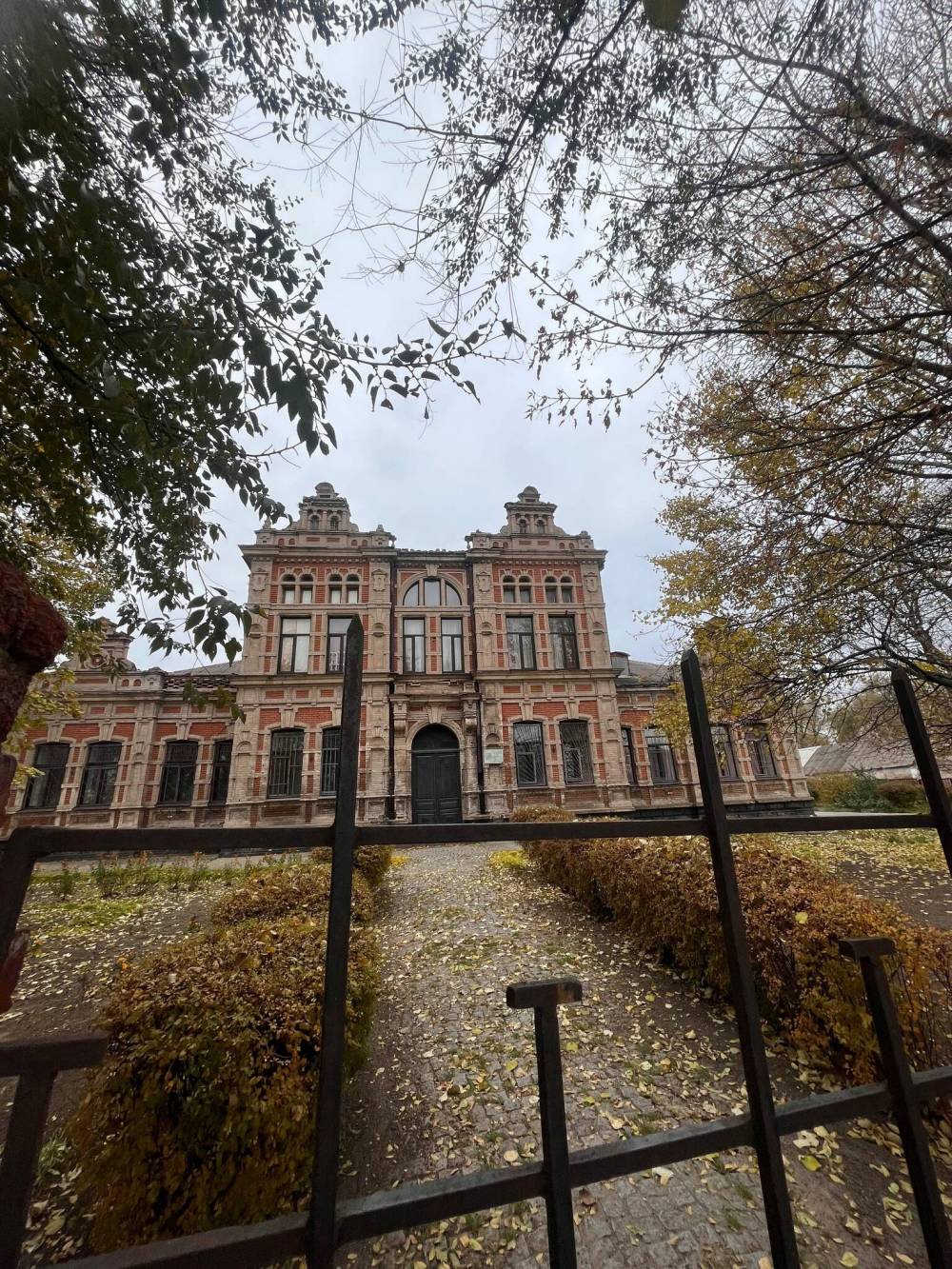
“This is the most beautiful building in Zaporizhzhia,” Akbash declares.
He may well be right. Built in 1904, the school is a gem of Art Nouveau architecture, blended with elements of Dutch Renaissance and late Baroque styles. It was funded by Katarina Valman, one of a family of wealthy Mennonite industrialists who, together with her husband Andreas Valman, gave generously to help build the city.
Around the corner from the school, another of the couple’s stately buildings, Zamok Valman — or Valman Castle — rises on a side street, its tiered construction and elegant red brick cutting a striking contrast with the more perfunctory mid-20th century buildings nearby.
“Few people expect to see such architecture here,” Akbash says, speaking through a translator. “People think Zaporizhzhia is Soviet.”
The school, which was made unisex during the Soviet era, isn’t operating anymore. It closed during the COVID-19 pandemic, and never reopened; recently, the city decided to shutter it for good. Akbash protested — “I even talked to the mayor,” he says — but the decision stood.
The building’s future is unclear. It’s safe from demolition, thanks to a state registry for historic sites; but no list can protect those structures from what most threatens them now.
“I worry about them all the time,” Akbash says, gazing at the school. “This area is most precious. Imagine if Russian missiles hit this building. It would be a shame to lose such a building.”
Akbash’s interest in the school is not solely academic: he’s also, he notes proudly, perhaps its most famous alumnus. He grew up in this neighbourhood, which is now called Upper Khortytsia — but was once Rosenthal Colony, home to a flourishing Mennonite community.
As a child in the waning years of the Soviet Union, Akbash marvelled at the school he attended, so much more ornate than others in Zaporizhzhia. Yet at the time, he says, the topic of Mennonite settlement in the area was “taboo,” as were details about the school’s origin.
“These buildings are my childhood,” he says. “I was interested in how it was built, who built it. Nobody told me. We didn’t have internet then, and nobody knew about it. Now, thank God, we are going back to this story. We can tell the truth about it.”
For Akbash, that spark of boyhood curiosity ignited a lifelong passion. Today, he’s one of Zaporizhzhia’s most celebrated local historians; before 2022, he made frequent media appearances, and led wildly popular walking tours of the city.
Then full-scale war came to Ukraine, and all of that changed.
Now, there are no tourists in Zaporizhzhia, which is situated just 35 kilometres from the front line. It’s far too dangerous. On the surface, life in the city goes through the motions of normalcy: people shop, walk their dogs, and sip beer at local pubs.
Yet here, staggering violence rains from the sky on a regular basis. Just days before our visit, ballistic missiles slammed into central Zaporizhzhia, killing six. A few weeks after we left, another attack smashed into a medical facility, killing 11 people.
ANDRIY ANDRIYENKO / THE ASSOCIATED PRESS FILES
Damage from a Russian missile attack in Zaporizhzhia in December 2024.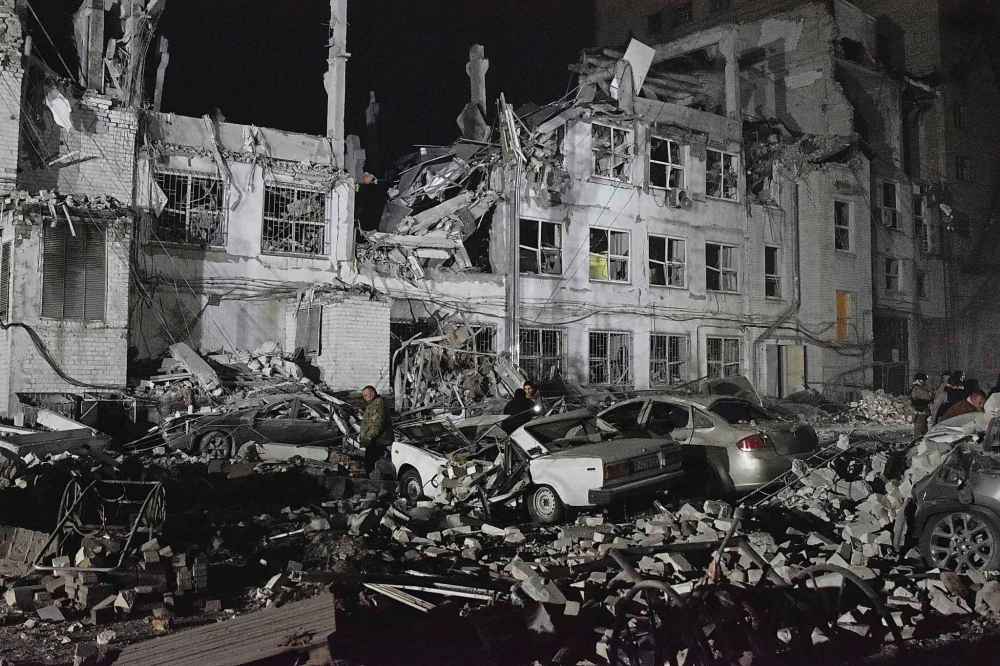
So far, most of the city’s key historic sites have been spared major damage. But even if there were tourists to see them, Akbash has no time now for tours. Though he still runs his popular Instagram account, war has transformed the historian into a soldier: in December 2023, he enlisted with the Ukrainian military, determined to help defend the city he loves.
That service has already come with a cost. Just a few weeks before our visit, Akbash was injured in the line of duty; after recovering in hospital, he was released to continue his recuperation at home. It’s the only reason he was free to show us around Zaporizhzhia.
Yet someday, Akbash knows, tourists will return — and many will be from Canada.
Though Mennonites left Ukraine in waves starting in the late 19th century, their connection to the region never faded. Before the invasion, Mennonite tour groups flocked to Zaporizhzhia. Streets were renamed in their honour; new monuments were erected.
Lost history was even uncovered: in 2019, one of the city’s most respected historians, Maksim Shtatskyi, unearthed a trove of 100 tombstones, inscribed with names such as Epp, Petkau and Hildebrand, which had been torn down by Soviet officials and used to build a barn.
MELISSA MARTIN / FREE PRESS As recently as 2019, a trove of tombstones inscribed with Mennonite names was unearthed.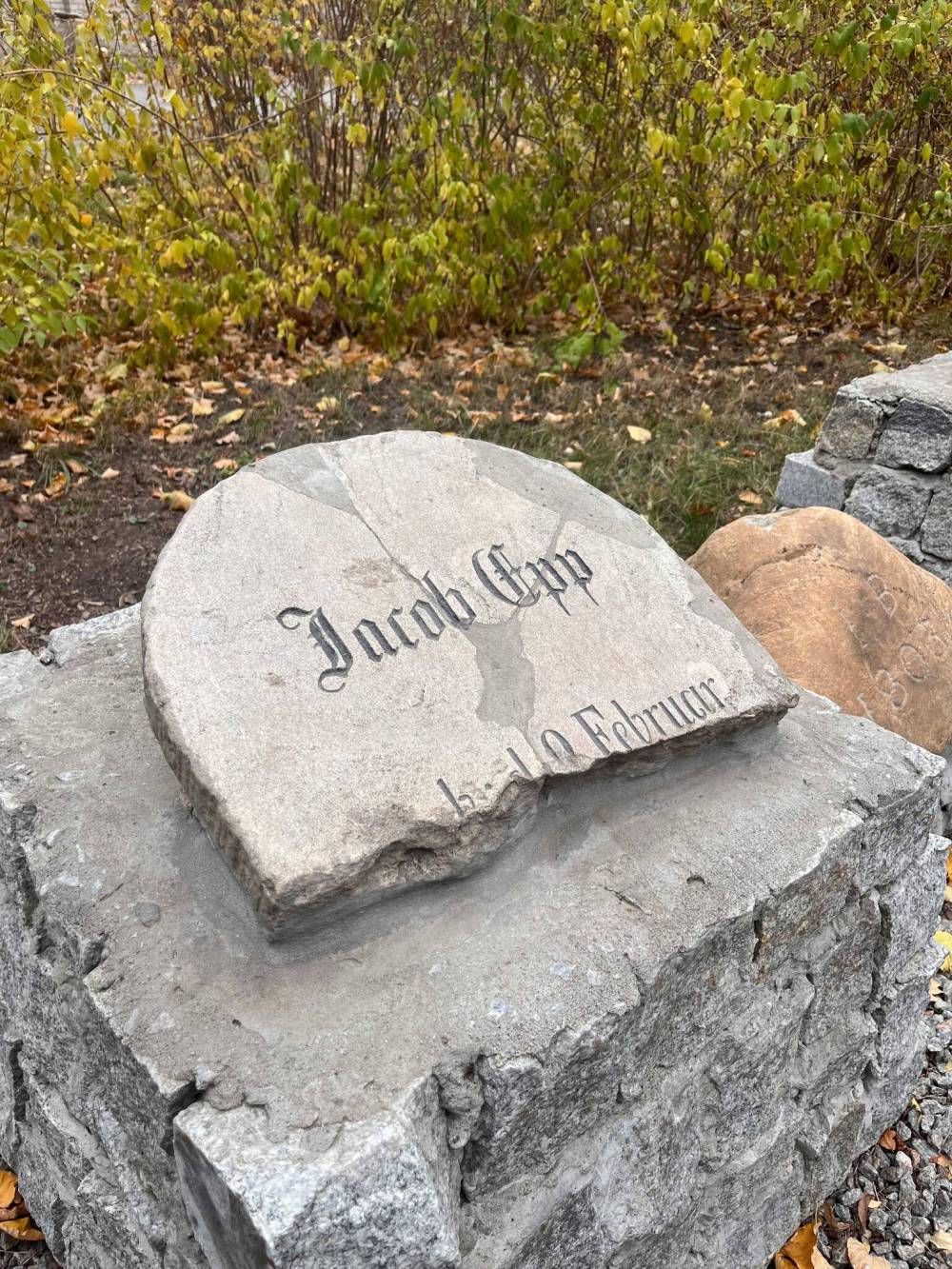
With financial support from Mennonites in Manitoba — who counted their ancestors among the markers discovered — Shtatskyi had 15 of the tombstones restored and arranged into a meditative memorial in on Khortytsia Island, in the middle of the Dnipro River.
The memorial was dedicated in a ceremony in June 2021, which was streamed online for those watching from afar. Eight months later, Russia invaded Ukraine, and Shtatksyi signed up to fight, taking the call sign Historian. In February 2024, he was killed in action.
Yet for all this resurgent interest in Anabaptist history in Zaporizhzhia, one part of the story remains largely untold.
At the Zaporizhzhia Regional Museum, curators have long had close contacts with Mennonites: “Before the war, we worked a lot with Mennonites from different countries,” says Olga Chaika, a senior scientist at the museum.
“There was even a conference, so many Mennonites from different countries came here. We created an exhibition in our big hall.”
The museum’s collection of Mennonite artifacts is vast. Chaika leads us through its halls, pointing out German-language Bibles, artfully carved wooden furniture, and objects inscribed with names of famous Mennonite entrepreneurs.
But of Hutterite history, the museum has almost nothing. Researchers would like to know more, she says, but that population was always small, and left few traces behind. To complicate matters, imperial Russian officials drew no distinction between groups; in their records, Hutterites are usually referred to as Mennonites.
Before our visit, Chaika reviewed the museum’s records. She knows about the first two Hutterite settlements in southern Ukraine; but of Hutterdorf, closer to Zaporizhzhia itself, she was not able to find any mention in their collection.
“Unfortunately, we don’t have enough information regarding this,” she says.
To reconnect that history is important, even during war.
MELISSA MARTIN / FREE PRESS For Roman Akbash, sharing Zaporizhzhia’s history is a form of resistance and a declaration of Ukrainian independence.
While we’re in Zaporizhzhia, Akbash takes us to see a flour mill, a six-storey building of green brick, set beside an unused rail spur.
When it was built at the end of the 19th century, Akbash says, it was one of the largest flour mills in Europe; today, Zaporizhzhia youth sometimes throw rave dance parties in its open warehouse spaces.
In 2023, a Russian missile slammed into a concrete industrial building directly beside the mill, smashing a hole straight down through its gut. The blast blew out many of the old mill’s windows and flung shrapnel into its walls; thankfully, it was otherwise unharmed.
War is about many things. It’s about land, and resources, and power. But it’s also about memory, and who gets to hold and define it. So for Akbash, sharing Zaporizhzhia’s history is also a form of resistance, and a declaration of Ukrainian independence.
“A person can’t value what he doesn’t know,” Akbash says. “If a person doesn’t know about the Mennonites, why would he care about their buildings? They were destroyed during the Soviet period due to the fact that people didn’t know their importance.”
He pauses.
“It’s a tragedy,” he continues. “And now, our neighbours destroy such buildings.”
In 1842, 384 Hutterites left northeastern Ukraine and made the long trek south, to the Zaporizhzhia region. They set up their first settlement, Hutterthal, near the small but growing city of Melitopol, close to the shores of the Sea of Azov.
At the time, they were not living communally: each of the 69 families that arrived in Hutterthal farmed their own tract of land.
The move turned out to be a good one. The land was fertile, and with support from Mennonite benefactor Johann Cornies, the Hutterites prospered and their community grew quickly.
By 1856 they’d built several more settlements, including Hutterdorf, about 35 kilometres southeast of the city of Zaporizhzhia.
While their economic prospects were on the rise in southern Ukraine, their social circumstances were more conflicted. The Hutterites worked closely with Mennonites, but the relationship was sometimes strained: Hutterites feared they’d be assimilated.
“They were riding on the coattails of the Mennonites at this point, and they were often lumped in with the Mennonites,” Wollmann says. “Some Hutterites weren’t happy with it, but they didn’t have any choice.”
To make matters worse, Cornies, who died in 1848, took a dim view of the Hutterites’ aspirations to reclaim communal life. In part to dissuade this, he sought to appoint administrators over each village, who would have final say over their affairs.
The move put Hutterites in a difficult spot. Hutterites already chose their own elders to lead them and were wary of losing their autonomy. Yet they needed Cornies’ support to keep going, so they could not limit his influence completely.
“The big question, the big tension for them in Ukraine was, ‘how are we going to govern our communities?’” Wollmann says, noting that some Hutterites also wanted to collaborate with Cornies. “These tensions simply demoralized the community.”
For a time, it seemed as if Hutterites might be destined to slowly fade away as a distinct people, and be absorbed into the much larger and wealthier Mennonite community. Then Michael Waldner fell off the train, hit his head and had his transformative vision.
Under Waldner’s leadership, in 1859 a group of families came together in Hutterdorf to pool their resources and build communal homes, worksites and social practices. In straightforward Hutterite fashion, they called themselves the Schmiedeleut — the blacksmith’s people.
Soon, another group would do the same, and for the first time in 40 years, Hutterites were living the way they’d always wanted, the way they believe Jesus’s first followers had modelled, and the way that defined them as a people: all together, and with all things in common.
DMYTRO SMOLIENKO / UKRINFORM / ZUMA PRESS WIRE The land beyond the city of Zaporizhzhia was farmed by Mennonite and Hutterite settlers more than a century earlier. 
They would not stay much longer in Ukraine.
As the 19th century entered its closing decades, Russian imperial authorities began to clamp down on the settlers. The government imposed mandatory Russian-language education and military service, which conflicted with the Anabaptist sects’ firm pacifist beliefs.
Once again, Hutterites sought a place where they could practise their faith and culture in peace. The Mennonites were too, so in 1873, scouts from both groups made their way across the Atlantic Ocean, bound for a tour of the American Midwest, which was eager to colonize the plains with European settlers.
When the Hutterites left Ukraine, they did it as they chose to live — together. In total, 1,265 of them left, including 400 who maintained communal living. Almost none stayed behind, save a handful who’d intermarried with Mennonites.
Waldner’s group, the Schmiedeleut, purchased 2,500 acres of land in South Dakota and established Bon Homme Colony, the first Hutterite settlement outside of Europe. (During the First World War, most Hutterites moved north, fleeing American pressure to submit to the military draft.)
The early years in North America were difficult, but in time the Hutterites began to thrive.
Today, there are roughly 50,000 Hutterites living in at least 569 communities, mostly on the Canadian Prairies. Nearly all of them trace their ancestry back to those 123 that first arrived in Ukraine — and all 117 communities in Manitoba are Schmiedeleut.
Over time, in Ukraine, the memory of their presence slipped away.
Records were lost or destroyed. History was suppressed. Settlements were renamed. Hutterthal became Kyrpychne; Hutterdorf, where Waldner revived communal life and set course for his people’s resurgence, became Kushchove.
Nearly all their buildings were razed by fire, reclaimed by nature or dismantled by poor farmers for brick. A revolution raged over the lands they once farmed, and then multiple wars.
Today, the first several Hutterite settlements in the Zaporizhzhia region are under Russian occupation, and the others are within 35 kilometres of the front.
Yet as traces of that history vanished from the Earth, they still linger on Hutterites’ tongues. Today, their unique Hutterisch dialect of German contains a handful of Ukrainian- and Russian-origin words, an audible testament to the journey of a people that were pushed to the eastern edge of Europe, persisted and survived.
Tscheinik, a tea kettle. Ussi, a moustache.
When Hutterites get married, they kick off the celebrations in the bride’s community with a beloved tradition, a day of feasting and festivities called the Hulba — which is also how you can describe a big party in Ukrainian.
MELISSA MARTIN / FREE PRESS Historians fear architectural wonders like Valman Castle will eventually be destroyed in missile strikes.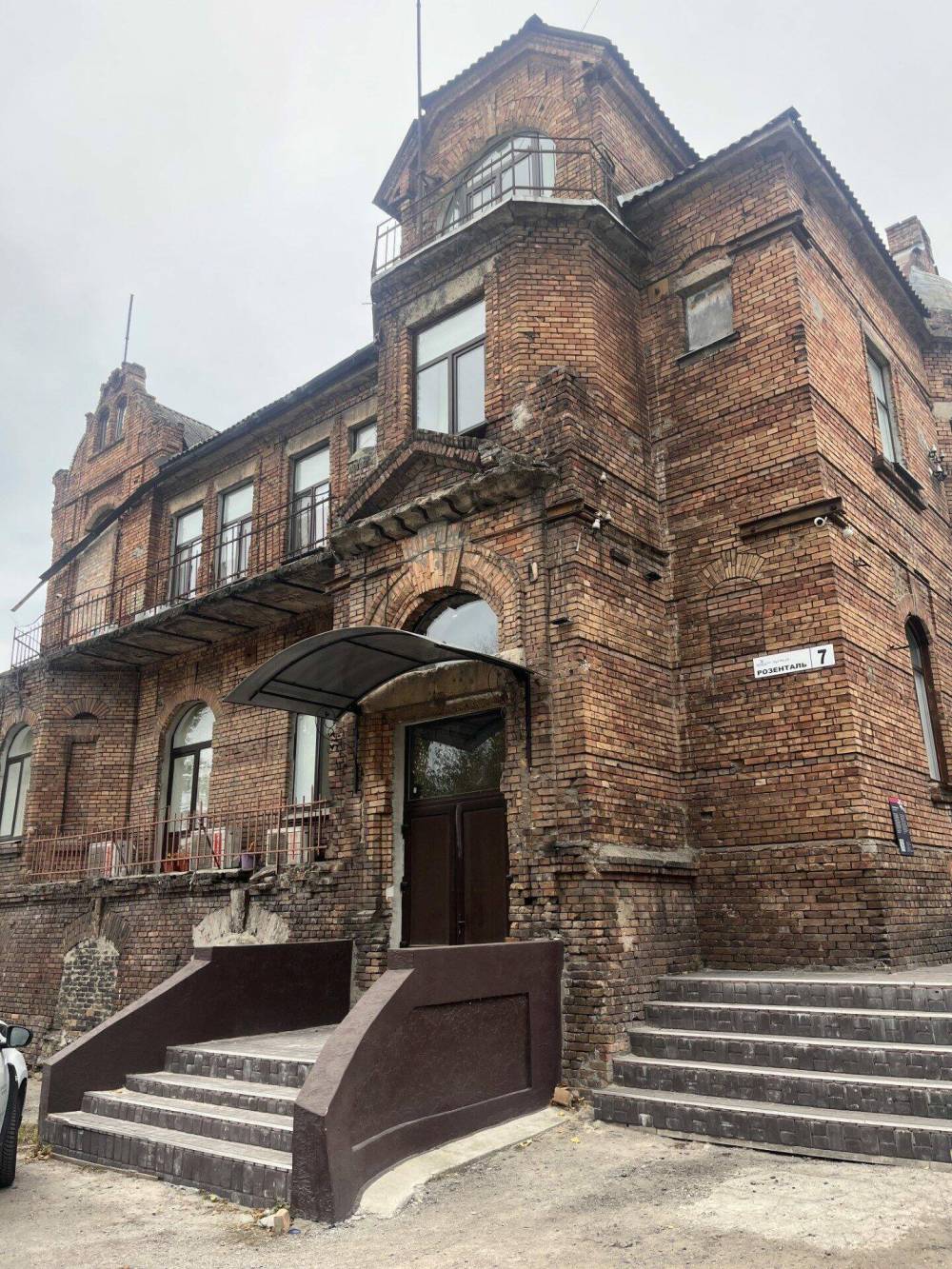
And there are still a few signs of Hutterite life in Ukraine, if you know where to look.
Consider the stately red bricks of Valman Castle, or the Mennonite girls’ school that Akbash attended, and considers the most beautiful in Zaporizhzhia.
They were funded by Andreas Valman, a wealthy industrialist, and his wife Katarina. The Valmans left a lasting legacy in the city: their names are inscribed on historical tourism markers across Zaporizhzhia.
But “Valman” is not how his last name was originally spelled. It metamorphosed when it was transliterated into Cyrillic, and then back into Roman letters.
Originally, he was not a Valman, but a Wollmann, one of the oldest Hutterite surnames. Andreas had married into a Mennonite family, grown wealthy, and so stayed behind when all the others left.
Over a century later, one of his distant relatives would be born in Manitoba, graduate from Canadian Mennonite University, and become one of the first trained Hutterite historians. He’d help publish books documenting his people’s story, including the latest, Navigating Tradition and Innovation, a collection of essays exploring the evolving dynamics of Hutterite life.
And as the fury of war pushed toward Zaporizhzhia, covering the places his ancestors had found space to rebuild their way of life, he would wonder what, if anything, remained of their pivotal years in that part of Ukraine.
A short drive up the road from Alla Andrusyeva’s office, a long white house sits alone on the edge of a broad green plain.
There are no other buildings nearby, save the ruins of a church that was long ago razed by the Bolsheviks, leaving jumbles of brick topped by a metal cross.
We slow the car to a halt at the house’s front gate. As we approach, a small brown dog in the yard erupts into a cacophony of frenzied barking. Alerted by the commotion, a woman rushes out of the house’s teal-blue door, peering at us with a surprised and cautious gaze.
MELISSA MARTIN / FREE PRESS One of the last known remaining Anabaptist-built houses in the region near Kushchove, a key Hutterite settlement in Ukraine.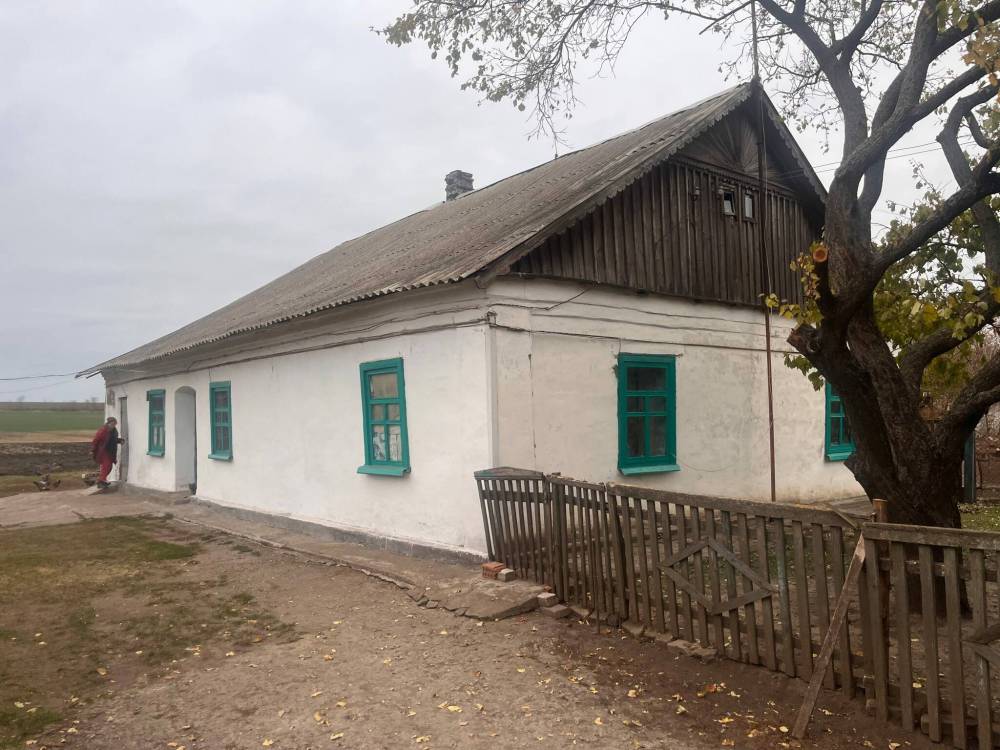
“He’s afraid of strangers,” Tatiana Yakovenko shouts over the din, speaking in Russian. “He only recognizes me.”
Andrusyeva walks up to greet her. The two women have known each other a long time: Yakovenko was once a deputy on the village council, where she’d entertain other members with vivid and uproariously funny accounts of her various woes.
“Journalists from Canada are here,” Andrusyeva explains. “They want to see where the Germans lived.”
Yakovenko’s eyes light up with delight. This is not the first time historically minded visitors have come knocking: about 15 years ago, she says, two women came and said they were writing a book about their ancestors who lived in the house.
She doesn’t know what happened to the book or the women. But she knows her house is a rarity, perhaps the last standing of what she calls the “German settlement” in the area, and she’s happy to talk with us about it.
I ask her if I can take her picture as we speak; at first she agrees, then hesitates.
MELISSA MARTIN / FREE PRESS As far as Tatiana Yakovenko knows, the house is at least 120 years old..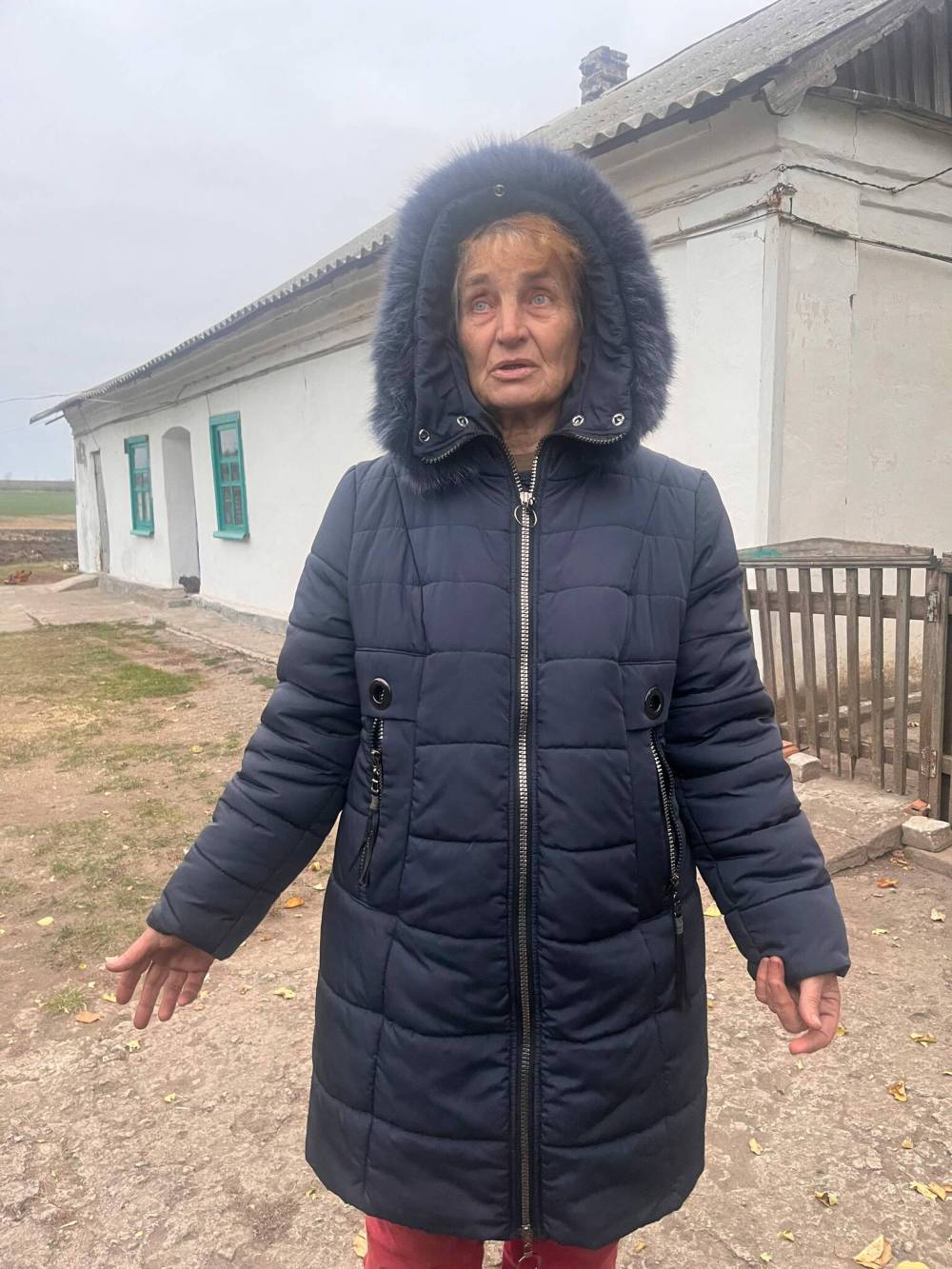
“All of Canada will run when they see me like this,” she exclaims, gesturing at her dusty red coat and wisps of orange-tipped silver hair made wild by the wind. She hustles back into her house to change clothes.
While Yakovenko gets ready, we circle the house, struck by how different it looks from the Ukrainian khatas of the region. It’s simpler than those structures, longer and more rectangular, with low plaster walls topped by a peaked roof of metal and weather-worn wood.
It’s hard to be certain when the house was built, or by whom. But in its shape and dimensions, it looks nearly identical to a Hutterite house that once stood in nearby Kushchove, which was photographed by a Hutterite visitor in 1976.
Yakovenko returns, now wearing a warm winter parka, and takes us on a tour of her yard. Chickens wander in and out of the house’s open side door, while a turkey struts past a pile of rusting scrap metal. On a windowsill, rows of young tomatoes sit ripening in the sun.
As far as Yakovenko knows, the house is at least 120 years old. She’s lived in it for 34 of those, many of them alone. Twice it suffered fire damage, and twice she had it repaired: this house, and the farmland attached to it, are the most precious things she has in the world.
Life in the old house is “comfortable,” Yakovenko says. The soil it sits on is rich, and she grows much of her own food.
There’s no running water — “It’s the only problem with this place” — though there is a well outside, with a notably wider aquifer than Ukrainians typically built.
She leads us down to the root cellar, which is also original to the property, pointing out its distinctive arched ceiling. (Its construction is very similar to early Hutterite root cellars in North America, Wollmann notes by text, when I send him pictures later that evening.)
MELISSA MARTIN / FREE PRESS The root cellar at Tatiana Yakovenko’s home features a distinctive arched ceiling that is similar to early Hutterite root cellars in North America.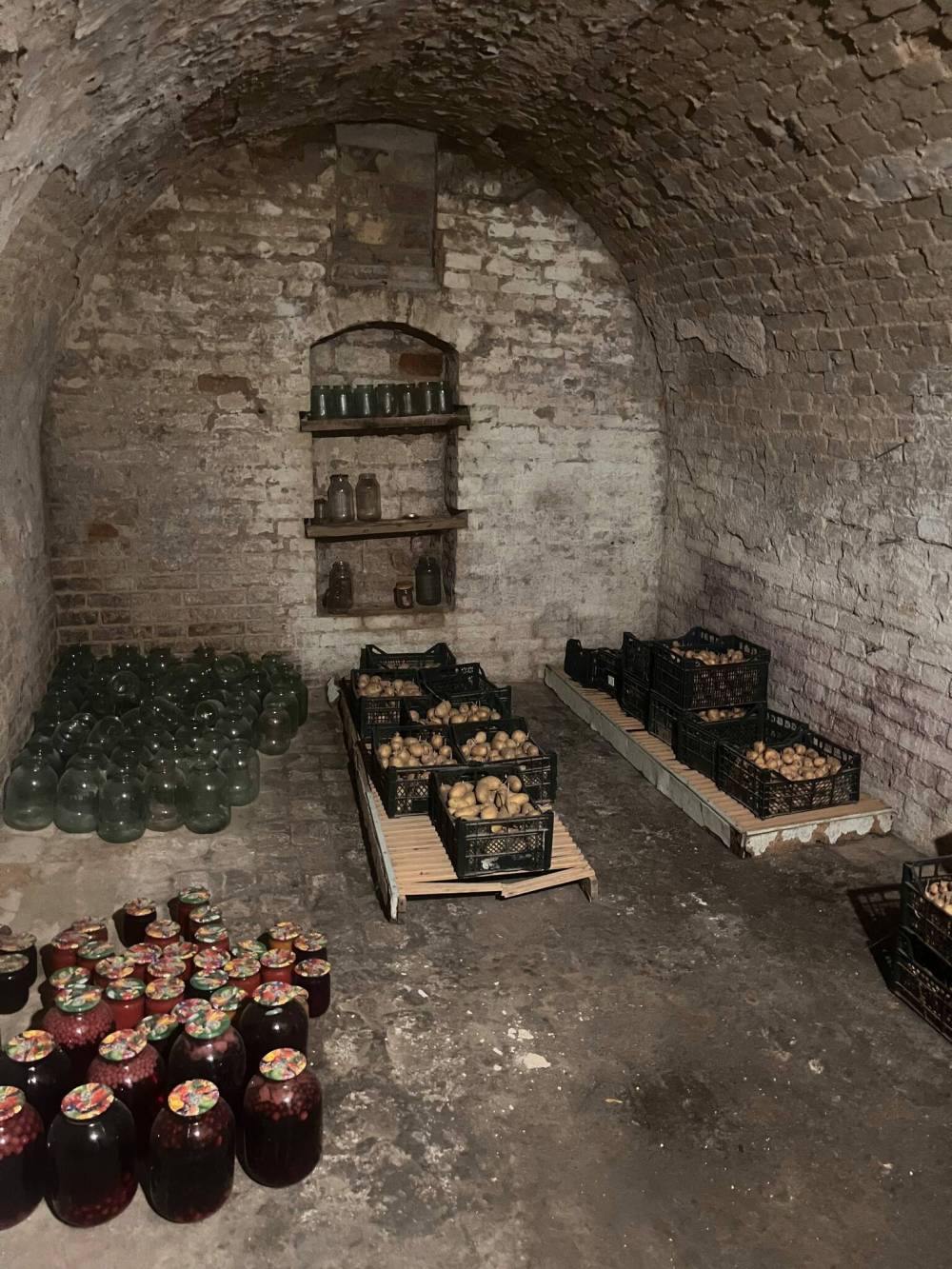
There, amidst jars of preserves and plastic crates of potatoes, Yakovenko begins to pour out her story, her voice rising and falling in a stream of words and melody. She tells us about her three sons, including one who’s served over a decade in the Ukrainian army.
Yakovenko is a woman of faith. When her son enlisted in 2014, shortly after Russian-led separatists seized parts of Ukraine’s eastern Donbas region, she went to the ruins of the church down the road, sat amidst the rubble, and stayed there for several days.
“When my child went to war, I lived under the cross,” she says. “I prayed for him, so that he would return with his arms and legs. He came back alive. Yes, he had a concussion, but he came back alive. (That church) is still a holy place.”
As we emerge from the root cellar, Yakovenko says she has three wishes for the future.
“First,” she says authoritatively, “the war should end soon. Second: everyone should be healthy and happy. And the third one: there should be no addicts, no alcoholics. This is what you need for happiness. Everything in the world should be clean and happy.”
She continues, the light sing-song of her voice rising over her dog’s continuing barking.
“Do I wish for money, or gold? No. I don’t need it,” she declares, with a flourish of her hand. “I have a house. I have a roof over my head. I have legs. I have hands. I’m walking on the Holy Land. What else do you need? I have three sons. I’m very happy.”
Dusk is falling over the fields. It’s time for us to return to Zaporizhzhia, past the military checkpoints, further away from the front line.
As we leave, Yakovenko embraces us tightly. Then she jolts upright, as if remembering something, and dashes inside the house. When she emerges, she hands us a pillowcase filled to the brim with walnuts she harvested from her land.
“They’re good for the heart, very good for health,” she chirps.
Somewhere in the far distance, a low rumble of artillery from a Ukrainian training ground reverberates over shorn fields. Yakovenko stands at the gate and waves vigorously as we climb back in the car and begin to drive away.
“Come back in summer,” she says, brightly. “We will have watermelons.”
Free Press writer Melissa Martin is currently on leave in Ukraine.

Melissa Martin
Reporter-at-large
Melissa Martin reports and opines for the Winnipeg Free Press.
Every piece of reporting Melissa produces is reviewed by an editing team before it is posted online or published in print — part of the Free Press‘s tradition, since 1872, of producing reliable independent journalism. Read more about Free Press’s history and mandate, and learn how our newsroom operates.
Our newsroom depends on a growing audience of readers to power our journalism. If you are not a paid reader, please consider becoming a subscriber.
Our newsroom depends on its audience of readers to power our journalism. Thank you for your support.
History
Updated on Friday, March 21, 2025 9:43 AM CDT: Corrects spelling of Schmiedeleut
Updated on Friday, March 21, 2025 11:57 AM CDT: Removes reference to cane


